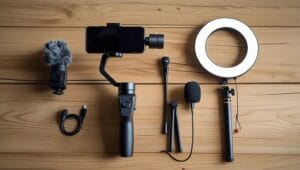The 5 Best Phone Gimbal Stabilizers for Cinematic Video in 2025
Tired of shaky, amateur-looking phone videos? You’re not alone. While smartphone cameras have become incredibly powerful, they still struggle with one major hurdle: stability. A phone gimbal stabilizer is the single most transformative tool you can buy to elevate your videography, turning jarring footage into smooth, gliding, cinematic shots that look like they came from a Hollywood production.
But with so many options on the market, choosing the right one can be daunting. As a professional who has spent countless hours testing these devices in the field, I’ve done the heavy lifting for you. We’ve analyzed everything from motor strength and battery life to the all-important companion app features. This guide breaks down the absolute best phone gimbals you can buy today, whether you’re a casual vlogger, an aspiring filmmaker, or a social media content creator.
Best Phone Gimbals of 2025: At a Glance
| Gimbal | Best For | Max Payload | Battery Life | Weight |
|---|---|---|---|---|
| DJI Osmo Mobile 7 | Overall Excellence | 290g | ~8 hours | 309g |
| Zhiyun Smooth 5S | Mobile Filmmakers | 320g | ~24 hours | 615g |
| Insta360 Flow | AI & Vlogging | 300g | ~12 hours | 369g |
| Hohem iSteady M6 | Heavy Phones & Features | 400g | ~18 hours | 551g |
| DJI Osmo Mobile SE | Beginners & Value | 290g | ~8 hours | 352g |
Affiliate Disclosure: As an Amazon Associate, we may earn from qualifying purchases through our links. This comes at no extra cost to you and helps us continue creating in-depth reviews.
How to Choose a Phone Gimbal: A Buyer’s Guide
Understanding the key features is essential before making a purchase. Here’s what to look for:
- Stabilization & Axes: Look for a 3-axis gimbal (pan, tilt, and roll). This is the industry standard and provides the smoothest, most comprehensive stabilization. Anything less will result in compromised footage.
- Payload Capacity: This is the maximum weight the gimbal’s motors can handle. Check your phone’s weight (with its case on!) and ensure it’s well below the gimbal’s max payload. Overloading the motors leads to poor performance and potential damage.
- The Companion App: The gimbal’s hardware is only half the story. The companion app (e.g., DJI Mimo, ZY Cami) unlocks its true potential. Look for apps with features like:
- Active Tracking: The ability to draw a box around a person or object and have the gimbal automatically follow it.
- Creative Shot Modes: Automated modes for creating Hyperlapses, Motionlapses, Dolly Zooms (Vertigo effect), and Panoramas.
- Manual Controls: For advanced users, the ability to control focus, zoom, ISO, and shutter speed from the gimbal itself is a huge plus.
- Portability & Build: How and where will you use it? Foldable gimbals are far more portable and convenient for travel. Consider the gimbal’s own weight—a lighter gimbal is more comfortable to hold for extended periods.
- Battery Life: Most modern gimbals offer at least 6-8 hours of battery life, which is plenty for a full day of shooting. Some models also support reverse charging, allowing you to top up your phone’s battery from the gimbal.
1. DJI Osmo Mobile 7 (OM7)

The perfect blend of power, portability, and ease of use.
The DJI Osmo Mobile series continues its reign with the hypothetical OM7. It refines what made its predecessors great: a brilliant magnetic clamp for instant setup, an incredibly intuitive app (DJI Mimo), and powerful, reliable motors. The ActiveTrack 6.0 technology offers the most tenacious subject tracking I’ve ever tested, locking onto subjects and holding on even when they briefly move behind obstacles. The built-in extension rod and simple joystick/wheel controls make it versatile for both simple vlogging and more complex shots. It’s the gimbal I recommend to 90% of people.
Pros
- Super-fast magnetic mounting system
- Best-in-class subject tracking (ActiveTrack)
- DJI Mimo app is polished and feature-rich
- Built-in extension rod for selfie/crane shots
Cons
- Plastic construction feels less premium than some rivals
- Fewer manual controls compared to Zhiyun
2. Zhiyun Smooth 5S

Unleash your inner cinematographer with pro-level controls.
If the DJI is a “smart” gimbal, the Zhiyun Smooth 5S is a “pro” gimbal. It’s larger, heavier, and built like a tank. Its key advantage lies in its abundance of physical controls. A large control wheel can be customized for focus or zoom, and an array of buttons and a joystick give you tactile command over nearly every setting, reducing the need to touch your phone’s screen. The motors are exceptionally powerful, easily handling the largest and heaviest smartphones with bulky cases and lens attachments. It also features a powerful built-in fill light, making it a complete package for serious creators.
Pros
- Robust build and powerful motors for heavy phones
- Extensive physical controls for focus, zoom, and settings
- Integrated magnetic fill light is bright and useful
- Excellent battery life
Cons
- Larger and heavier, less portable
- Steeper learning curve for beginners
- Companion apps (ZY Cami/StaCam) are less intuitive than DJI’s
3. Insta360 Flow

The smartest, most compact gimbal for solo creators.
The Insta360 Flow is a marvel of engineering and AI. It’s incredibly compact, unfolding in a single motion, and combines a gimbal, selfie stick, and tripod all into one device. Its standout feature is its “Deep Track 3.0” AI. In my tests, its subject tracking is on par with, and sometimes even surpasses, DJI’s. It can re-identify a subject after they’ve left the frame and offers creative modes like “Basketball Mode” for tracking hoops. The companion app is packed with AI-powered editing features that can automatically cut together a story from your clips. For vloggers and solo shooters, the Flow is an unmatched creative partner.
Pros
- All-in-one compact design (gimbal, tripod, selfie stick)
- World-class AI subject tracking
- Powerful app with intuitive editing features
- Very fast to deploy and start shooting
Cons
- Joystick control is less precise than rivals
- Can feel slightly less robust than DJI or Zhiyun
4. Hohem iSteady M6 Kit

The powerhouse that handles anything you throw at it.
If you have a massive phone like a Samsung Galaxy S23 Ultra or an iPhone 14 Pro Max with a case and moment lens, you need a gimbal with beastly motors. The Hohem iSteady M6 is that gimbal. With a class-leading 400g payload, it handles heavy setups without breaking a sweat. The “Kit” version is the one to get, as it includes a brilliant magnetic AI vision sensor. This sensor provides excellent face and object tracking *independently* of the app, meaning you can use its tracking features with your phone’s native camera app or even Filmic Pro. Combined with four accessory ports and a 360° infinite panning mode, this is a tinkerer’s dream.
Pros
- Massive 400g payload capacity
- Magnetic AI tracker works with any camera app
- Incredible 18-hour battery life
- Excellent value for the features offered
Cons
- Larger and heavier build
- The Hohem Joy app is less polished than competitors
5. DJI Osmo Mobile SE

Get the core DJI experience for a fraction of the price.
Want the fantastic DJI ecosystem without the flagship price? The Osmo Mobile SE is your answer. It offers the same core 3-axis stabilization, the same powerful DJI Mimo app, and the same great ActiveTrack technology as its more expensive sibling. So, what’s the catch? It uses a traditional spring-loaded clamp instead of the convenient magnetic one, and it lacks the built-in extension rod. For many users, these are minor omissions. If you’re just starting out and want a no-fuss, high-performing gimbal that delivers buttery smooth video, the OM SE provides unbeatable value.
Pros
- Access to the excellent DJI Mimo app and ActiveTrack
- Superb stabilization performance for the price
- Simple, easy-to-use design
- Compact and lightweight
Cons
- Traditional clamp is slower than magnetic mounts
- No built-in extension rod
Frequently Asked Questions (FAQ)
For most modern gimbals and standard-sized phones, you only need a rough initial balance. The motors are strong enough to compensate for minor imperfections. However, getting it as close to balanced as possible before powering on will reduce strain on the motors and improve battery life. If you use a very heavy phone or add accessories, precise balancing becomes more important.
Usually, yes. Most gimbals can accommodate slim to medium-sized cases. The two limiting factors are the clamp’s physical width and the total weight (payload). If you have a very thick, rugged, or battery case, you may need to remove it or opt for a gimbal with a higher payload capacity like the Hohem iSteady M6 or Zhiyun Smooth 5S.
A selfie stick or tripod simply holds your phone in place. A gimbal is an active stabilization device with motors and sensors. It constantly works to counteract your hand movements on three axes (pan, tilt, roll) to produce incredibly smooth, floating video footage. A tripod is for static shots; a gimbal is for smooth shots while in motion.
Yes, you can. The gimbal will still provide stabilization. However, you will lose access to all the app-integrated features like active tracking, dolly zoom, and using the gimbal’s physical buttons to start/stop recording or zoom. For the best experience, using the manufacturer’s companion app is highly recommended. The exception is a gimbal like the Hohem iSteady M6 Kit, whose AI tracker works independently of the app.


